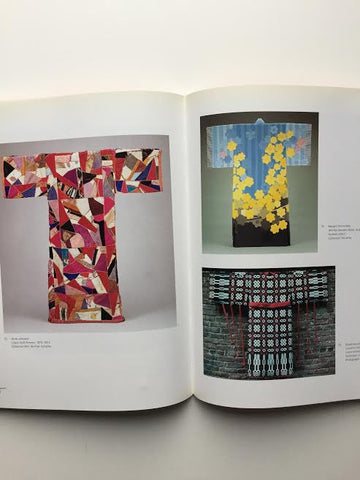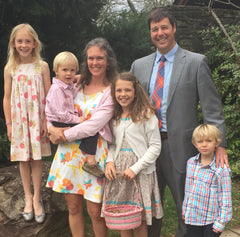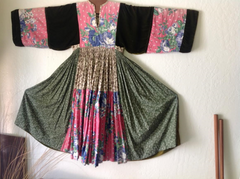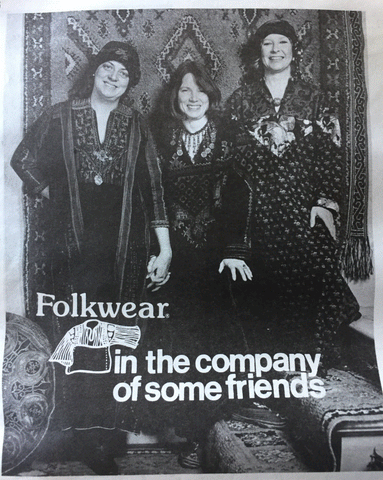- Home
- About
-
Shop
-
Sewing Patterns
-
Fabric
- Sewing Supplies
- Folkwear Clothing
-
- Blog
- Customer Gallery
- Contact
April 17, 2017
Kimonos are a beautiful and classic garment of Japanese origin and influence. The Folkwear Kimono pattern is for the yukata, or unlined informal kimono, worn by all classes of Japanese in summer. The word "kimono" literally means "clothing" but has come to distinguish the Japanese national costume from other clothes.
Kimonos are great garments to be used as robes, house coats, jackets, or outwear. They can be statement pieces or simple and elegant garments. Kimonos can be made with beautiful silks, medium to lightweight cottons (cotton gauze is a favorite of mine right now)., or even heavier fabrics like denim or brocade.
I found a great book in our collection entitled Kimono Inspiration: Art and Art-to-Wear in America, from the Textile Museum at George Washington University. I've put some pictures from the book on our Facebook and Instagram accounts. If you want to know more about the history and tradition of kimonos, as well as see some amazing artistic interpretations of them, you should check out this book. Kimonos can be a canvas for your art - quilting, painting, dying, embroidery, weaving, etc.
from the book on our Facebook and Instagram accounts. If you want to know more about the history and tradition of kimonos, as well as see some amazing artistic interpretations of them, you should check out this book. Kimonos can be a canvas for your art - quilting, painting, dying, embroidery, weaving, etc.
Traditional kimonos are a work of art themselves, so however you want to make one (traditional interpretation or modern art interpretation), it is a rewarding garment to make.
In our kimono pattern, we give information on the history and use of the kimono, styling and dress information, and instructions for traditional handwork (sashiko) and dyeing (shibori).
Have you ever made a kimono? What would you be inspired to make now?
** FYI, #113 Japanese Kimono is on sale for all of April (it is a great deal). Enjoy! **
April 01, 2017 7 Comments on About me
I thought I should probably tell you all a little about myself! I am Molly Hamilton, the current owner of Folkwear. I am a relatively new owner of Folkwear, just taking over at the end of December 2016 (more of the history here), and I am slowly working on transitioning Folkwear to be more digitally accessible, while remaining true to its roots - and fun to explore and learn!
I grew up in a small farming town in northeastern North Carolina (considered “the South” in the US), where my grandparents were very influential in my life. My grandfather was a farmer and my grandmother a farm wife who cooked, raised 3 daughters, and was an amazing seamstress.
I learned to sew from my grandmother. As a child, I hand-sewed Barbie dresses and machine-sewed lined notebook paper so I would learn to sew straight lines. I finally got into sewing with patterns when I was in college, and I loved it! I sewed through college - mostly concentrating on important dresses that I loved but rarely wore.
I got married to a wonderful man soon after graduating from college, and moved to the beautiful mountains of NC, near Asheville, where my husband’s family has a farm (two actually). Here is where we remain, excepting 2 years when we lived in Raleigh and went to graduate school. I have worked part-time for NC State University for nearly 13 years, doing Extension outreach for organic grain production in our state. Here you can see the farming influence from my grandfather. Agriculture, especially sustainable agriculture, is important to me.
However, I got more excited about sewing after I had my first baby 12 years ago, and a friend gave me a baby present of a large bag filled with sewing patterns for children, cute girly fabrics, thread, and lots of gorgeous trim and notions. I had so much fun with that present! I started sewing as much as I could - clothes for my children, clothes for myself, items for the house.
We now have 4 children - 2 girls and 2 boys (ages from 12 to 4). They love getting the clothes I make for them and I love to sew for them. They are wonderful children - delightful, fun, and lots of work! They are a priority (which is why I am usually not at the Folkwear office in the afternoon/after-school hours), and I love being their mother.
clothes I make for them and I love to sew for them. They are wonderful children - delightful, fun, and lots of work! They are a priority (which is why I am usually not at the Folkwear office in the afternoon/after-school hours), and I love being their mother.
In the last few years I started drafting patterns for myself and my children. I enjoyed it, even though most of the time I had no idea what I was doing - but it worked (mostly!). I also got more involved in the local sewing and art scene, and last year exhibited two outfits I made for a juried Local Cloth fashion show.
I love working for Folkwear and love this company. When I am not sewing or working or taking care of my family, I love to hike (right from my house), garden, read, and just sit and watch the view.
I love to hear from customers too, and see what you all are making. We have a new Facebook Group for customers and fans to share what they are making, ask advice, and chat. It is called Folkwear Patterns Sewing Group. So, join if you are on Facebook and we will get to know each other!

March 28, 2017 4 Comments on Did you know . . . ??

Though I have been a fan of Folkwear for years, I am still the “new” owner of Folkwear, and I am learning a LOT about this company as I go about the daily business of its business. I am trying to wrap my head around the 40 years of history of this independent pattern company, and all the work, details, and passion and so many women have put into (speaking of which, I loved reading the comments from this blog post from Fringe Association). So, I thought I would list a few interesting facts I’ve learned about Folkwear over the past months,
Did you know . . .


March 20, 2017 2 Comments on Pattern Profile: #107 Afghan Nomad Dress




I am starting a series of blog posts (called "Pattern Profiles") that will provide a little more information on each pattern - from its history to geographical, cultural, and historical context, to sewing info. I won't be going in pattern numerical order, but will be picking patterns due to their popularity, seasonality, or perhaps just by whim. So, I hope you'll follow along and enjoy! (and feel free to suggest a pattern for us to cover)
And, I want to start this series with #107 Afghan Nomad Dress. This dress has gotten some love lately: a few customers have sent me pictures of their creations (above), and one is being shown right now at the NYC Museum of Art and Design exhibit "Counter-Couture" (the very top one). It seems everyone who has made this dress loves it.
The pattern features a full skirt and high-waisted bodice, with full three-piece sleeves and arm gussets. With no zippers or button closures (just an opening in the back), this dress is not hard to construct, and can be a way to display multiple beautiful fabrics.
This dress is traditionally worn by nomadic women in Afghanistan and neighboring countries (along the "Silk Road"). Typically, the dresses have embroidery at all the openings - neck, cuffs, and hem. This is said to repel evil spirits. The Folkwear pattern includes three traditional embroidery patterns, as well as some techniques for adding fringe, beads, and shisha mirrors.
Various fabrics are often used in one dress - plain or printed cotton, silk, and sometimes patches of velvet. To be most authentic when making this dress, you can mix colors and prints will wild abandon! The traditional costume is completed by a veil hanging down the back and gathered trousers under the skirt. But, this dress is great however you wish to wear it.
March 12, 2017
It seems like the 1960s and 70s are “in” right now. There has been a renewed interest in the era of free love, peace movements, and the creativity that sprang from youth of the time, especially around fashion. The 1960s and 1970s were known for the renewed and creative use of traditional textile craft such as embroidery, applique, dying, and crochet in clothing to create unique and colorful garments. There is a great article in this month's Vanity Fair about the summer of 1967 and its impact on fashion and culture in America - the era from which Folkwear sprang (note: link only show pictures from article, you must be a subscriber to read the article).
This month a new exhibit called “Counter-Couture: Handmade Fashion in American Counterculture” opened at the Museum of Art and Design in New York City. This exhibition was organized by Bellevue Arts Museum, Bellevue, Washington, and curated by Guest Curator Michael Cepress. And, Folkwear has a connection to it!
One of the original Folkwear dresses is in the collection on display. Alexandra Jacopetti Hart, one of the founders of Folkwear designed and created the dress when creating the Afghan Nomad Dress (#107) pattern when they founded the company in the mid 1970s.

Folkwear's #107 Afghan Nomad Dress on exhibit at the NY MAD Counter-Couture exhibit. Made by Alexandra Hart.
If you want to check out the exhibit, click on any of the links below and you will see great photos of the garments on display - and learn quite a bit more about the period and fashion. See if you can spot Folkwear’s Afghan Nomad Dress! Bonus if you can find a version of the Gaza Dress (#101) in there too!
Exhibit is open until August 10, 2017
Links to view exhibit (if you can't make it to NYC):
Exhibition Link Online with photos of the installation: http://madmuseum.org/exhibition/counter-coutureNew York Times Video:
https://www.facebook.com/nytimesstyles/videos/1429433023762899/
Womenswear Daily:
Arts Summary - A Visual Tour:
Stylecurated:
http://stylecurated.blogspot.com/2017/03/counter-couture-handmade-fashion-in.html
Accessories Magazine:
https://www.accessoriesmagazine.com/149349/museum-arts-design-opens-counter-couture-exhibit
March 10, 2017 16 Comments on The History of Folkwear
The History of Folkwear
In the mid-1970s, three

The three founders were a perfect team to create a line of innovative patterns that was revolutionary for its time—this was the mid 1970s when women's wear in
During the recession of the mid-1980s, Folkwear's business health suffered along with so many other small businesses. The company was sold to The Taunton Press, publisher of Threads magazine, and by the early 1990s most of the original patterns were back in print and new patterns were under development.
In 1998,

So many different types of people use Folkwear patterns. There are historic re-enactors, Renaissance Faire participants, theater costume designers, and lovers of creative art-to-wear. Residents of historic neighborhoods and members of antique auto clubs use the patterns to dress to the appropriate historic period for their annual events. Folks who adopt children from other countries use the patterns to teach the little ones about their native cultures. Swing, tango, and ballroom dancers love to use the patterns for their passion. Living history museums and Universal Studios dress their staff in Folkwear patterns. The The male actors in the first television episode of The Lonesome Dove all wore a Folkwear pattern (#204
In 2002, Mathews purchased the Folkwear pattern division. Folkwear became, yet again, an independent, woman-owned firm, just like it was in its earliest days. Mathews ran Folkwear for 14 years, adding many new patterns to the collection. Folkwear was sold in late 2016 to Molly Hamilton, a young woman and fellow sewer, in Asheville who currently owns and runs the company. Through it all, the company has retained a loyal group of fans who keep the passion for vintage and ethnic garments alive! And, Gretchen Schields has continued to illustrate nearly all of the patterns since the inception of the company until 2017, contributing to the iconic images associated with Folkwear patterns.
-- written by Kate Mathews - fiber artist, sewer, weaver, and former owner of Folkwear
March 08, 2017 1 Comment on Welcome to Folkwear's new website!
Welcome to Folkwear’s new website! We are so excited to have this new website, shop, and blog in order to share with you Folkwear patterns, and information on sewing, costuming, embellishing, and the history and culture of all our sewing patterns. The new on-line shop is fabulous! It will be easier to navigate, easy to place your order, and (maybe most exciting for you!) most shipping prices will be lower than ever before!
The shop is organized by categories, and each pattern has illustrations, pictures, and line drawings. We plan for the blog to showcase our patterns, provide sew-alongs and tutorials, and feature relevant news and events in fashion and sewing. There should be fun things to check out here on a regular basis! And, you can subscribe to our newsletter by entering your email address at the bottom of our page. Thanks for joining us!
